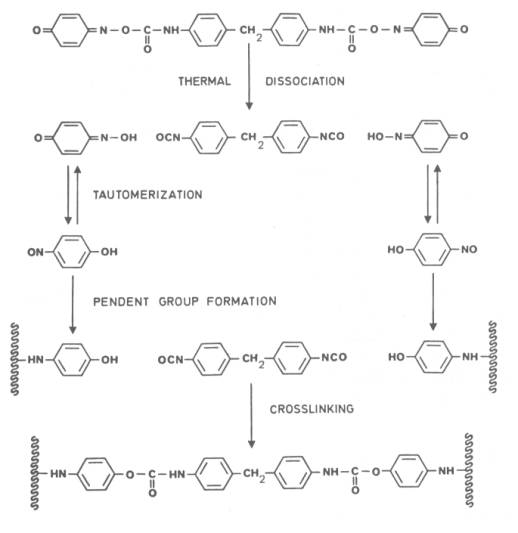
VULCANISATION BY URETHANE SYSTEM
Mohammad Azizol Abdul Wahab
One of the newest vulcanising agents to gain commercial acceptance is a urethane crosslinker discovered by scientist at the Malaysian Rubber producers Research Association (MRPRA) in England and developed by Hughson Chemicals, Lord Corp., in the United States. Presently marketed by Durham Chemicals in England, by far the most popular type is sold under the tradename Novor 924.
MRPRA applied the term urethane to these materials because of their analogy with regular urethane compounds and Novor 924 is and adduct from a substituted nitrosophenol and toluene diisocynate. It is dustless, free-flowing powder, 75% active ingredient and 25% naphthenic oil. Due to the nature of its components it is an expensive vulcanising agent. Because of the unique properties it imparts it may be economical in certain cases, especially when used with sulphur vulcanising system.
Recently it has been used with NR although there are literature references to its use with SBR and Neoprene. Urethane crosslinkers were developed to improve the resistance to reversion and ageing of natural compounds. Due to relatively short time they have been in use and their reactivity, their functioning has not been fully determined.
The core mechanisms involved in using the urethane crosslinker like Novor 924 is shown in figure 5.1.

Figure 5.1: Crosslinking with Novor curing agent
(Courtesy of Plastics and Rubber Institute (Malaysian
Section)).
Urethane crosslinkers are not used alone but always with a catalyst such as ZDMC which acts to increase the formation of pendant groups. In addition a drying agent like calcium oxide is used to absorb moisture present in the rubber compound which might hydrolyse free isocynate producing carbon dioxide and causing porosity in the vulcanisates. In most cases for economy urethane crosslinkers are used in conjunction with sulphur curing systems. Fortunately the two systems are synergistic, which further reduces the cost.
With the co-vulcanising systems NR compound can be devised that are resistant to reversion and heat ageing and have improved fatigue after ageing. Other advantages include extending the range of temperature for curing NR and increased hardness of a compound compared to that from equivalent sulphur-cured vulcanisates. These advantages have resulted in Novor compounds being used for bags, rollers, engine mounts and solid tyres.
Compounding and handling of stock mixed with urethane crosslinkers is distinctly different from those using conventional curing agents. As mention earlier, calcium oxide is usually added to absorb moisture which otherwise would hydrolyse the isocynate. But in addition to this, fillers with high moisture content should be avoided and stocks stored in a dry place and immersion in cooling tanks limited or avoided. In some instances wrapping the stock tightly in polyethylene film may be necessary.
Typical curing systems are as follows:
100% B Novor Cure
Novor 924 6.7 pphr (equivalent to 5.0 pphr active ingredient)
ZDMC 2.0 pphr
Calcium Oxide 3.0 pphr
Novor/Sulphur Mixed Systems (80:20 ratio is typical)
Novor 924 4.2 pphr
Sulphur 0.4 pphr
TMTM 1.3 pphr
Santocure NS 0.08 pphr
However, you may found the 50:50 formulae suggested by Brydson .